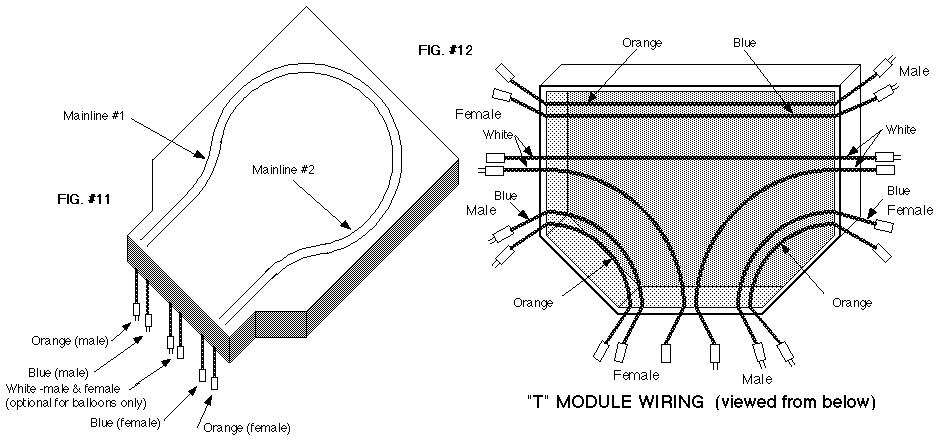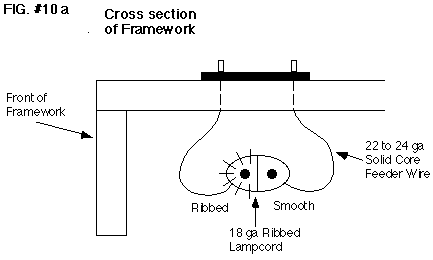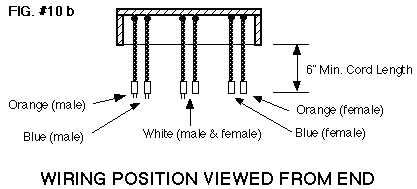Copyright © 2018 by Andrew Reid - BendTrack · All Rights reserved · E-Mail: andrew@bendtrack.com
The Home of BendTrack
The BendTrack Manual -- Wiring & Electrical
Designed & Hosted by JunctionDesign
As with N-Trak, BendTrack uses no smaller than 18 gauge lamp cord for mainline
power and no smaller than 16 gauge lamp cord for the 12 volt white power line. Since
the modules are double sided, you will have six cords running across the underside of
the module. At the ends of these cords, Bend Track uses the same two pin Cinch-Jones
plugs that N-Trak specifies.
For the feeder wires, use 22 to 24 gauge solid core wire to tap power from the
orange/blue mainline cords to the rails. BendTrack also uses the same method for
observing the polarity of both mainline and white line cords. The ribbed wire is
connected to the wide pin of the Cinch-Jones plug and to the front rail of each mainline.
12 volts is carried by the wide pin of the Cinch-Jones plug and the ribbed wire and
ground is carried by the small pin and smooth wire of the white cord.
Wiring Specifications
The orange/blue cables should approximately follow under the appropriate mainlines, much the same as they do on any modular layout. This will greatly simplify wiring repairs & troubleshooting down the road. We suggest implementing some sort of colour-code on the wiring, as well, for much the same reasons.
Wire Sizes
If possible, at the ends of the module, the orange/blue cords should remain close to the outside edges under the appropriate mains. The white cords should remain close to the center. This will keep them in line when the modules are clamped together and keep the white 12 volt lines away from the mainlines to reduce the chance of 12 volts getting plugged into a mainline. Be sure to leave a length of wire below the bench work on both ends to allow an adequate amount of cord to plug into the next module...6 inches will suffice, but we've found lengths closer to 12" make connecting under the modules easier.
Positions of Wires & Plugs
| Wire | Plug Colour | Minimum Gauge |
| Mainline #1 | Orange | 18ga (16ga advised) |
| Mainline #2 | Blue | 18ga (16ga advised) |
| 12V Accy | White | 16ga |
Since the BendTrack module is like having two N-Trak modules which are connected back to back, you will have six wires hanging down on each end of the module instead of N-Trak's 4 wires. The front rail should be soldered to the ribbed side of the lamp cord which is then soldered to the wide pin of the CINCH JONES plug. Repeat this process for all mainline connector plugs. If you're using a heavier gauge wire instead of lamp cord, just make sure you're consistent...this is where that colour-coding idea really starts to come good!
An easy way to remember where the male and female Cinch-Jones plugs go is to notice that as you view a Bend Track module from the side (not from an end), the right hand end always has the male plug and the left hand end always has the female plugs for the pair of mainlines closest to the viewer.
A "T" module has three sides but the "right hand rule" still applies as you look at each side by itself. The right hand rule for the gender of the Cinch-Jones plugs guarantees that any module can be rotated any way and still connect to other modules that have not been rotated.
A "T" module has three sides but the "right hand rule" still applies as you look at each side by itself. The right hand rule for the gender of the Cinch-Jones plugs guarantees that any module can be rotated any way and still connect to other modules that have not been rotated.
Balloon Wiring
Balloons have a small change to the required wiring. Since they only have one end to connect, they need less cords than a standard end. The only cords needed are the orange/blue cords to feed the mains. The white cords are optional on balloon modules. This is because the white male/female Cinch-Jones plugs at the outer end of the last non-balloon module of the branch can be plugged into each other to make the continuous connection for the white line.
At this point the purpose of the white cords should be mentioned. They serve the same purpose for Bend Track as they do in N-Trak in that they provide a 12 volt power supply which we can tap off of for use on mainline throttles, yard or local cabs or anything that needs 12 volts of power such as lights, signals, etc. A DPST (double pole, single throw) or DPDT (double pole, double throw) switch or some kind of disconnection must be included for BOTH CONDUCTORS of the white line if you are using power from it for your module so that if problems arise, the switch can be shut off to isolate the problem from the rest of the white line. A properly sized fuse is also a must!
If thought of properly, Bend Track wiring is identical in concept to that of N-Trak with the exception of one less mainline and the use of different color codes.
At this point the purpose of the white cords should be mentioned. They serve the same purpose for Bend Track as they do in N-Trak in that they provide a 12 volt power supply which we can tap off of for use on mainline throttles, yard or local cabs or anything that needs 12 volts of power such as lights, signals, etc. A DPST (double pole, single throw) or DPDT (double pole, double throw) switch or some kind of disconnection must be included for BOTH CONDUCTORS of the white line if you are using power from it for your module so that if problems arise, the switch can be shut off to isolate the problem from the rest of the white line. A properly sized fuse is also a must!
If thought of properly, Bend Track wiring is identical in concept to that of N-Trak with the exception of one less mainline and the use of different color codes.

Just a Quick Note...Since the standard was written, power demands and control systems have changed for many modellers. Many of the BendTrack & N-Trak groups have slightly updated their standards to reflect the use of a minimum 16ga power bus, terminated into Anderson PowerPole connectors. Several groups have chosen to eliminate the accessory "White" 12V supply wiring under the modules, as well. It's best to check with your local group (if applicable) to see what modifications or adjustments they may have made to make the BendTrack standard work best for them.
The Original "N"ovative Modular System

Home
The Manual
Whats New?
History
Tips & Tricks
Links
Photo Gallery
Clubs & Groups
Support Us
Contact Us
As with N-Trak, BendTrack uses no smaller than 18 gauge lamp cord for mainline power and no smaller than 16 gauge
lamp cord for the 12 volt white power line. Since the modules are double sided, you will have six cords running across the
underside of the module. At the ends of these cords, Bend Track uses the same two pin Cinch-Jones plugs that N-Trak
specifies.
For the feeder wires, use 22 to 24 gauge solid core wire to tap power from the orange/blue mainline cords to the rails.
BendTrack also uses the same method for observing the polarity of both mainline and white line cords. The ribbed wire is
connected to the wide pin of the Cinch-Jones plug and to the front rail of each mainline. 12 volts is carried by the wide pin of the
Cinch-Jones plug and the ribbed wire and ground is carried by the small pin and smooth wire of the white cord.
Just a Quick Note...Since the standard was written, power demands and control systems have changed for many modellers. Many of the BendTrack & N-Trak groups have slightly updated their standards to reflect the use of a minimum 16ga power bus, terminated into Anderson PowerPole connectors. Several groups have chosen to eliminate the accessory "White" 12V supply wiring under the modules, as well. It's best to check with your local group (if applicable) to see what modifications or adjustments they may have made to make the BendTrack standard work best for them.
Since the BendTrack module is like having two N-Trak modules which are connected back to back, you will have six wires hanging down on each end of the module instead of N-Trak's 4 wires. The front rail should be soldered to the ribbed side of the lamp cord which is then soldered to the wide pin of the CINCH JONES plug. Repeat this process for all mainline connector plugs.
If you're using a heavier gauge wire instead of lamp cord, just make sure you're consistent ... this is where that colour-coding idea really starts to come good!
An easy way to remember where the male and female Cinch-Jones plugs go is to notice that as you view a Bend Track module from the side (not from an end), the right hand end always has the male plug and the left hand end always has the female plugs for the pair of mainlines closest to the viewer.
A "T" module has three sides but the "right hand rule" still applies as you look at each side by itself. The right hand rule for the gender of the Cinch-Jones plugs guarantees that any module can be rotated any way and still connect to other modules that have not been rotated.
The Original "N"ovative
Modular System
Modular System
As with N-Trak, BendTrack uses no
smaller than 18 gauge lamp cord for
mainline power and no smaller than 16
gauge lamp cord for the 12 volt white
power line. Since the modules are double
sided, you will have six cords running
across the underside of the module. At the
ends of these cords, Bend Track uses the
same two pin Cinch-Jones plugs that N-
Trak specifies.
For the feeder wires, use 22 to 24
gauge solid core wire to tap power from
the orange/blue mainline cords to the rails.
BendTrack also uses the same method for
observing the polarity of both mainline and
white line cords. The ribbed wire is
connected to the wide pin of the Cinch-
Jones plug and to the front rail of each
mainline. 12 volts is carried by the wide pin
of the Cinch-Jones plug and the ribbed
wire and ground is carried by the small pin
and smooth wire of the white cord.

Copyright © 2018 by Andrew Reid - BendTrack
All Rights reserved
E-Mail: andrew@bendtrack.com
All Rights reserved
E-Mail: andrew@bendtrack.com

Click Logo to go to the Top of the Page




